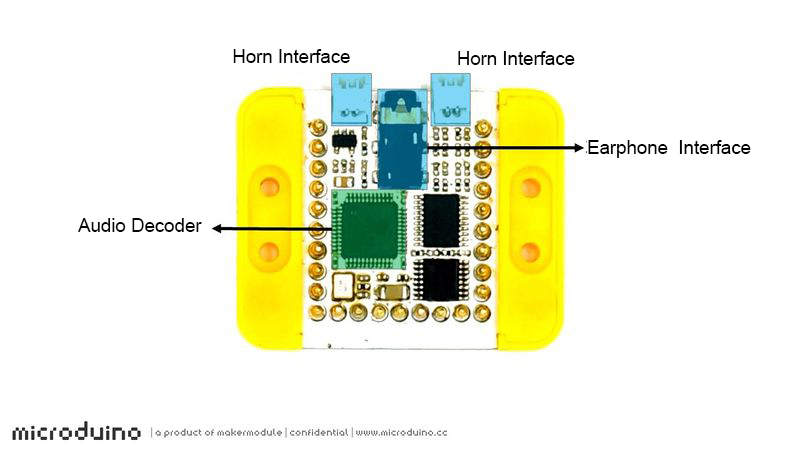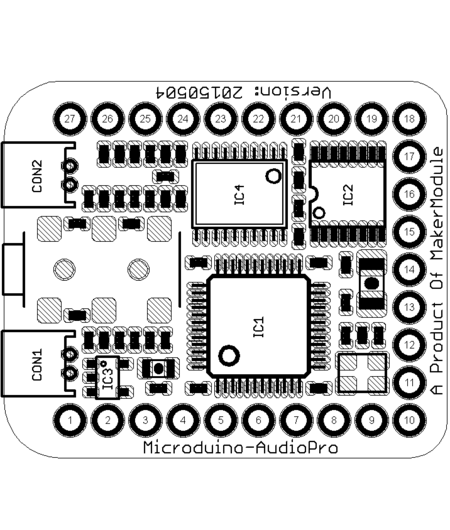|
Microduino AudioPro is a multi-function audio module with VS1053 as the decoder, and it integrates 2.2W stereo amplifier, and supports 2.5mm stereo headphone interface and MIDI function. This module is usually used with the mCookie SD module to play music files.
Features
- Support multiple formats of decoding:MP3/WMA/AAC/WAV/Ogg Vorbis/MIDI;
- Can real-time simulate as many as 128 kinds of MIDI instruments;
- Integrate 2.2w stereo amplifier;
- With 2.5mm stereo headphone interface onboard;
- Headphone/extrovert automatically switching function;
- SPI high-speed communication interface;
- Small, cheap, stackable and open;
- The open-source hardware circuit design and compatible-with-Arduino programming development environment;
- The unified Microduino interface specification and abundant peripheral modules, which make it can be extended and connected with other modules and sensors which meet Microduino interface specification, quickly, conveniently and flexibly;
- 2.54-spacing mother line interface is convenient for integrating to the hole plate.
Specification
- Support multiple formats of decoding: MP3/WMA/AAC/WAV/Ogg Vorbis/MIDI;
- Can real-time simulate as many as 128 kinds of MIDI instruments:
- The universal MIDI and SP‐MIDI format 0 file can be played, and the format 1 and 2 file must be changed into format 0 by the players;
- The number of polyphony is 64 at most, and the number of continuous polyphony is 40 at most.
- Integrate 2.2w stereo amplifier(LM4863):
- Can control enabled through the GPIO4 of VS1053.
- 2.5mm stereo headphone interface onboard;
- Head/extrovert automatically switching function;
- 18-bit-oversampling, multi-bit, and sigma‐delta high-precision DAC:
- Oversampling generally refers to the higher sampling rate more than nominal sampling rate for integral number of times, which is commonly used to improve the sampling accuracy. It means when restore the digital voice, use the sampling rate several times more than the nominal sampling rate to output, which can make the steps of the audio steep gently, and low the digital background noise and reduce the distortion, thereby get the high-quality audio superior to the output effect of the original sampling rate.
- SPI high-speed communication interface;
- Electrical characteristics:
- VS1053: 3.3V, 30~60mA;
- LM4863: 5V, 1A.
Description of Pins
- D2 pin is the real-time MIDI interface:
- The real-time MIDI is not enabled by default. If you need to enable it, just short connect the jumper on the back of the module;
- After enabling the real-time MIDI, the baud rate of UART should be 31250bps, and at this time, SPI interface will not be available.
| Name of AudioPro pin |
Microduino pin |
Function
|
| SCK |
D13 |
SPI bus clock
|
| SI |
D12 |
Data input pin
|
| SO |
D11 |
Data output pin
|
| CS |
A3 |
SPI chip select signal (need to be defined in the program)
|
| DCS |
A2 |
Data/command mode choose (need to be defined in the program)
|
| DERQ |
3 |
Interrupt output (need to be defined in the program)
|
| MIDI |
2 |
MIDI input (not enabled by default)
|
Documents
Development
- You can test the function through the _06_Microduino_AudioPlus_VS1053 library:github;
- Related example programs to download:github:
- Thereinto, Audio_MIDI is the example program of SPI interface realizes the real-time MIDI through loading the patches;
- Thereinto, Audio_ROM is the example program of playing audio files in ROM.
- You can see the MIDI material in the attachment;
- Tool for the hexadecimal to audio files:File:DataToHex.zip.
Application
FAQ
History
Gallery
Video
Attachment
MIDI numbers,Note names and frequencies
You can refer to:NUSW
|
|
- Note names, MIDI numbers and frequencies are related here in tables and via an application that converts them. The musical interval between two notes depends on the ratio of their frequencies.
- An octave is a ratio of 2:1 and, in equal temperament, an octave comprises 12 equal semitones. Each semitone therefore has a ratio of 21/12 (approximately 1.059). By convention, A4 is often set at 440 Hz. These data were used to calculate the first table below, which gives the frequency of any standard keyboard note or MIDI note number. To convert from any frequency to pitch (i.e. to the nearest note and how far it is out of tune).
- This table is reproduced inverted below, i.e. with high pitch at the top.
- To convert from any frequency to pitch (i.e. to the nearest note and how far it is out of tune, go to the frequency to note converter written by Andrew Botros.
- How to do the calculation? Suppose that two notes have frequencies f1 and f2, and a frequency ratio of f2/f1. An octave is a ratio of 2:1, so the number of octaves between f2 and f1 is
- Now to divide the octave into smaller units. In equal temperament, where all semitones have the same frequency ratio of 21/12, conversion between note name and frequency is simple. First, one needs a reference note and frequency. This is usually A4, which is often set at 440 Hz. For a note that lies n semitones higher (or −n semitones lower), the frequency is then
- Conversely, one can obtain n, the number of semitones from A4, from
- Similar equations give no, the number of octaves from A4, and nc, the number of cents from A4:
- no = log2(fn/440 Hz) and nc = 1200*log2(fn/440 Hz).
- In electronic music, pitch is often given by MIDI number: let's call it m for our purposes. m for the note A4 is 69 and increases by one for each equal tempered semitone, so this gives us a simple conversion between frequencies and MIDI numbers (again using 440 Hz as the pitch of A4):
- m = 12*log2(fm/440 Hz) + 69 and fm = 2(m−69)/12(440 Hz).
- The notation used here is not universal: in German speaking countries, H is used instead of B, and B is used for Bb. (This allowed Bach to write his name in the Art of Fugue.) And of course when different tuning systems are used, different names are applied.
|
MIDI(GM1)
MIDI(GM1+GM2)
- 27-High Q
- 28-Slap
- 29-Scratch Push
- 30-Scratch Pull
- 31-Sticks
- 32-Square Click
- 33-Metronome Click
- 34-Metronome Bell
- 35-Acoustic Bass Drum)
- 36-Bass Drum 1
- 37-Side Stick
- 38-Acoustic Snare
- 39-Hand Clap
- 40-Electric Snare
- 41-Low Floor Tom
- 42-Closed Hi-Hat
- 43-High Floor Tom
- 44-Pedal Hi-Hat
- 45-Low Tom
- 46-Open Hi-Hat
- 47-Low-Mid Tom
- 48-Hi-Mid Tom
|
- 49-Crash Cymbal 1
- 50-High Tom
- 51-Ride Cymbal 1
- 52-Chinese Cymbal
- 53-Ride Bell
- 54-Tambourine
- 55-Splash Cymbal
- 56-Cowbell
- 57-Crash Cymbal 2
- 58-Vibraslap
- 59-Ride Cymbal 2
- 60-High Bongo
- 61-Low Bongo
- 62-Mute Hi Conga
- 63-Open Hi Conga
- 64-Low Conga
- 65-High Timbale
- 66-Low Timbale
- 67-High Agogo
- 68-Low Agogo
- 69-Cabasa
- 70-Maracas
|
- 71-Short Whistle
- 72-Long Whistle
- 73-Short Guiro
- 74-Long Guiro
- 75-Claves
- 76-Hi Wood Block
- 77-Low Wood Block
- 78-Mute Cuica
- 79-Open Cuica
- 80-Mute Triangle
- 81-Open Triangle
- 82-Shaker
- 83-Jingle Bell
- 84-Bell Tree
- 85-Castinets
- 86-Mute Surdo
- 87-Open Surdo
|
|




